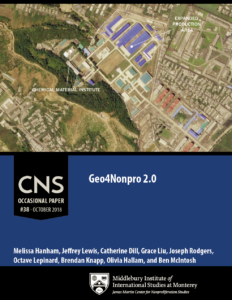October 9, 2018
Melissa Hanham, Jeffrey Lewis, Catherine Dill, Grace Liu, Joseph Rodgers, Octave Lepinard, Brendan Knapp, Olivia Hallam, and Ben McIntosh
On June 16, 2018, the James Martin Center for Nonproliferation Studies (CNS) launched Geo4Nonpro 2.0. With a mission to engage a “curated” crowd of satellite imagery analysis experts, Geo4Nonpro (G4N) is a tool for sharing open-source geographic information of known or suspected weapons of mass destruction (WMD) sites.
CNS broke several international news stories in major outlets—including, inter alia, the New York Times, National Public Radio, and the Wall Street Journal—using imagery on G4N. It has served as the ideal platform for people located around the world to collaborate on satellite-imagery analysis.
The most impressive discovery was North Korea’s Kangson uranium-enrichment facility. CNS believes it to be the first time this facility has been identified or analyzed in the open-source literature. It represents the possibility that North Korea has been producing—and can continue to produce—as much, if not more, fissile material for nuclear weapons than it could have using the only previously known enrichment site at Yongbyon.
The first section of this report discusses the evolution of the platform: from the conception of Geo4Nonpro 1.0 and the initial training of G4N team members, to the lessons learned during the first phase of the project and how these lessons fed into the platform’s continued development. The second section describes the launch of Geo4Nonpro 2.0, its new features, and highlights news stories that featured Geo4Nonpro and the central role that it played in many of these discoveries. This is followed by an analysis of each campaign. Lastly, the team proposes the next steps and future applications for this innovative platform.

